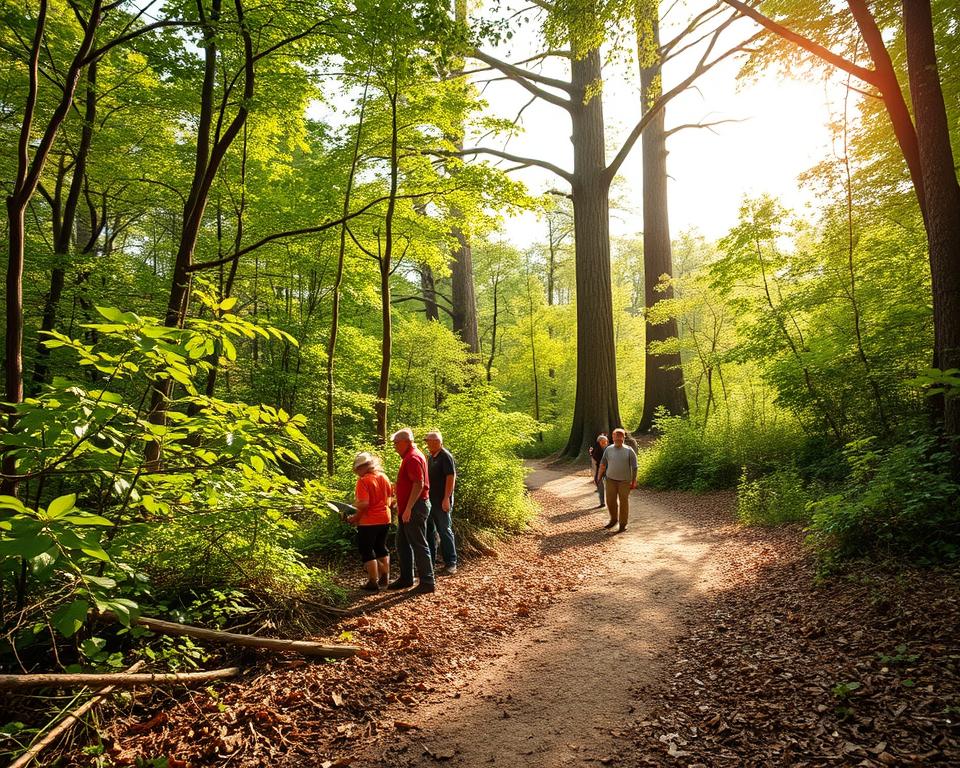Specialist Pointers: Open Paths in Forest Estate
Have you realize nearly eighty percent of homeowners with forest grounds rarely explore past their yard? This figure underscores the vital requirement for effective trail clearing and maintenance. Clearing paths and trails in forest areas not only enhances reachability but also enhances safety and wayfinding. The following piece will delve into professional techniques and insights from seasoned trail builders.
These experts will provide ways to design well-constructed trails that maximize your outdoor area’s utility while maintaining its environmental integrity. Discover the key factors for forestry mulching near me and techniques for effective forest property upkeep solutions. Such can make your journey through your outdoor environment more pleasant.
Notable Observations
- Grasping the value of clearing paths for reach and security.
- Evaluating location attributes to determine the objective of your trails.
- Using the right tools for effective trail clearing.
- Choosing suitable surfaces that align with terrain type.
- Adopting sustainable practices when clearing trails.
- Identifying common mistakes to avoid during the trail-clearing process.
Why Clearing Trails in Forested Grounds Matters
Maintaining open routes in wooded zones is crucial for several reasons. It significantly improves ease of access, making it easier to traverse thick bushes. This allows property owners and visitors to fully enjoy the landscape. This clearing also facilitates various activities like walking, birdwatching, or just relishing nature.
Improving Usability
Open paths not only facilitate travel; they also deepen our link with the natural world. By improving access, owners open up the outdoors to more people. This is useful for personal use or community events, fostering exploration and valorization of the surroundings.
Ensuring Security and Wayfinding
The importance of security on woodland trails is paramount. Defined routes offer clear wayfinding and minimize risks from rough ground, hidden obstacles, or abrupt plant growth shifts. Property owners commit in creating safe paths, increasing assurance in wilderness adventures.

Planning Your Woodland Trail
Effective path design demands a deep understanding of the terrain. It’s about assessing terrain and location conditions. Understanding the path’s purpose is also crucial, as it shapes design and upkeep.
Evaluating Terrain and Site Conditions
When evaluating terrain, multiple elements are critical. They include:
- Ground compositions that influence water flow and stability
- Slope degree impacting ease of access and safety
- Existing vegetation that may need removal or protection
By assessing these factors, paths can endure various weather conditions. They also support frequent pedestrian use. This approach guarantees the trail is durable and honors the land’s original characteristics.
Setting the Trail Objective
Path design achievement relies on a clear objective. Think about the activities the path will support, such as:
- Leisurely strolling and outdoor appreciation
- Entry for upkeep or ground management
- Opportunities for wildlife observation and education
Understanding the path’s goal directs multiple choices. Such understanding includes the trail’s breadth and building supplies. Recognizing the path’s goal is vital for creating a path that meets its requirements.
Essential Equipment for Path Opening
Productive path opening demands the proper tools for different jobs. The correct equipment increase efficiency and security, streamlining the procedure. The selection between manual tools and motorized equipment varies with the task’s scale, ground, and amount of debris.
Essential Hand Tools
Hand tools are key for accuracy and versatility in opening dense zones. Essential implements include:
- Pruning loppers: Great for slicing heavy branches and shrubs.
- Hand saws: Ideal for detailed cuts on wood limbs.
- Ho-dads: Useful for excavating and creating water channels.
These tools offer a hands-on approach, crucial for sensitive spots where heavy equipment could harm.
Motorized Tools for Speed
For big path clearing jobs, power tools are a game-changer. Such equipment make the task speedier and more productive. Key tools include:
- Chain saws: Excellent for cutting down big trees and slicing dense underbrush.
- Brushcutters: Quick for clearing thick turf and smaller saplings.
Motorized tools cuts down clearing duration, making it ideal for large areas. Secure operation is imperative to prevent accidents.
Strategies for Clearing Paths and Trails in Wooded Property
Opening routes and trails in forest grounds requires thoughtful preparation. It is vital to balance practicality with eco-friendliness. Efficient plant control ensures the environment’s harmony while creating useful pathways. This equilibrium is crucial to a pleasant exterior experience.
Managing Dense Plant Life
Selective clearing methods are vital when tackling overgrowth. Manual implements enable for accurate extraction of undesirable plants without damaging the ecosystem. Such approach encourages the growth of desired species while controlling invasive ones. Ongoing maintenance stops regrowth, enhancing trail safety and accessibility.
Designing Eco-Friendly Trails
A sustainable path design is more than aesthetic; it includes choosing materials that reduce soil loss and improve water runoff. These strategies respect the natural landscape and reduce ecological impact. Using native stones or reclaimed wood bolsters durable durability and environmental balance. Careful planning achieves a balance between usability and eco-protection.
Trail Surface Options: Finding the Right Fit
Choosing the right path surface is vital for both functionality and durability. The choice between organic and artificial coverings affects maintenance, comfort, and trail longevity. Understanding the different materials and their suitability for your ground is crucial to creating an optimal path.
Organic versus Synthetic Trail Covers
Organic ground covers, such as gravel, broken rock, or mulch, are often less costly. They integrate well with the environment, facilitating drainage and a natural appearance. In comparison, man-made surfaces like masonry tiles are more durable and appropriate for heavy use. Every type has its benefits and disadvantages, depending the intended application and climate factors.
Choosing the Right Materials for Your Terrain
Selecting the suitable materials involves considering soil type, drainage needs, and cost constraints. Below is a basic guide to popular materials:
| Material | Advantages | Disadvantages | Cost per Square Foot |
|---|---|---|---|
| Gravel | Inexpensive, Effective water flow | Requires regular top-up | $1 – $3 |
| Crushed Stone | Stable surface, Natural look | Can be difficult to walk on in wet conditions | $2 – $5 |
| Wood Chips | Eco-friendly, Soft underfoot | Needs frequent topping up | $1 – $2 |
| Concrete Pavers | Tough, Minimal upkeep | Higher upfront cost | $5 – $15 |
Thoughtfully selecting trail surface materials guarantees your paths are practical and compliment the site’s natural beauty.
Constructing Elevated Walkways
Creating trails in wooded grounds requires careful consideration of elevation changes. This is crucial for smooth transitions across different terrains and maintaining path usability over time. Building bridges for trails is often required, mainly when crossing marshy spots or low-lying ground.
Identifying When to Add Height Variations
Elevation in trail layout is often due to uneven landscapes. Major level changes necessitate structures like bridges or turnpikes to preserve path integrity. This method helps avoid ground washout and maintains security, vital for both casual hikers and serious nature lovers.
Choosing Bridge Materials for Marshy Terrain
The choice of supplies for elevated walkways and overpasses is key for their security and longevity. Logs, masonry units, or treated lumber can provide the required support against load and environmental factors. It’s crucial to choose materials that are moisture-proof to avoid decay and allow subsequent modifications.
Trail Maintenance and Upkeep
Keeping paths safe and accessible demands ongoing maintenance. Frequent checks assist in spotting problems early, ensuring users have a positive experience. It’s vital to upkeep trails throughout the year, as climatic shifts can damage them. This section will outline a detailed upkeep guide and the benefits of employing professional trail maintenance services.
Year-Round Upkeep Tasks
A complete guide helps path custodians keep their paths in top condition year-round. Key tasks include:
- Clearing debris such as downed limbs and foliage.
- Checking path layers for wear and tear, following bad weather.
- Checking water channels to avoid water buildup.
- Fixing soil washout by supplementing gravel as needed.
- Updating markers and signs for clear direction.
Expert Path Care Providers
For those needing professional help, specialized trail maintenance services are a excellent option. They provide:
- Comprehensive path evaluations by experienced professionals.
- Specialized repairs and rehabilitation of busy paths.
- Employing dedicated machinery for improved path treatment.
- Implementing eco-friendly practices to prolong path longevity.
Engaging professional path care saves time for other outdoor pursuits. It also brings in expert skill.
Beautifying Trail Borders
Landscaping is key to making paths attractive. By carefully choosing plants and elements, you can craft an welcoming environment. This not only draws visitors but also supports local habitats. The right plants for trails provide beauty and maintain environmental stability.
Incorporating Flora for Aesthetic Appeal
When designing pathside planting, selecting the appropriate plants is essential. Local species are perfect as they organically blend with the surroundings. They need less maintenance and offer habitat for local wildlife. Mix blooming flora, shrubs, and grasses for a diverse, attractive ambiance around paths.
Using Stones and Edging Materials
Border supplies like stones and pavers are vital for path form. They define the route and add its aesthetic. These elements prevent soil erosion and provide a neat contrast with plants. Using different finishes and hues can render the trail more engaging.
Eco-Friendly Path Preparation
Path clearing projects should focus on environmental sustainability. Sustainable ground care methods help protect the area’s environmental health. This method makes sure paths coexist with nature peacefully.
Sustainable Practices for Land Management
Embracing sustainable practices in trail opening is critical. Low-impact techniques minimize soil erosion and safeguard ecosystems. Selective clearing and eco-friendly materials minimize damage.
Learning the terrain and vegetation is crucial. It aids responsible land management and enhances trail usability.
Impact on Local Wildlife and Flora
Fauna evaluations are vital in path development. They assist measure the task’s effect on local fauna and flora. This permits for necessary adjustments before building begins.
Identifying sensitive species’ habitats avoids environment disruption. This balance ensures a vibrant ecosystem for every form of life.
Path constructors can create eco-friendly routes with careful preparation. This focus to eco-friendly practices and wildlife well-being enhances outdoor experiences. It reconciles leisure pursuits with eco-protection.
Pitfalls to Avoid in Path Opening
Engaging in path opening requires steering clear of common errors to avoid ongoing issues. Recognizing these errors enables for better preparation and implementation. By emphasizing straightforward path design and managing water flow, one can prevent extensive upkeep demands.
Over-Complicating the Path Design
Trail management often falls into the pitfall of overengineering trail design. Numerous enthusiasts think complex designs render trails more appealing. However, straightforwardness is often the key to success. Straightforward routes improve wayfinding and maintenance, reducing hurdles.
Avoidable twists and elaborate elements can cause path mistakes. These problems hinder usage and wayfinding, making paths less enjoyable.
Neglecting Water Management
Ignoring water control issues in trails can have severe consequences. Proper water management avoids water accumulation, which can erode trails and damage grounds. Adequate drainage solutions are essential for a durable trail.
Ensuring water flows away from the path safeguards the route and preserves the ecosystem. This allows for a more enjoyable outdoor experience.
To Summarize
Path opening is vital for those who wish to completely enjoy their wooded grounds. It improves accessibility and security, making outdoor areas enjoyable for everyone. Forest trails offer more than just scenic appeal; they offer opportunities for recreation and learning about the environment.
Successful planning and execution are crucial in path opening. Evaluating ground and choosing the proper materials are vital for creating durable routes. Ongoing maintenance keeps these trails secure and accessible, fostering a ongoing link with nature.
By grasping the concepts outlined here, you can plan and maintain paths that serve both practical and leisure purposes. Adopting woodland paths can turn your grounds into a haven for adventure, relaxation, and appreciating nature.
